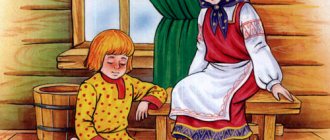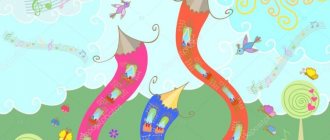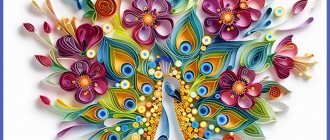Table: lesson notes by K. V. Tovmasyan on the topic “Honesty in L. N. Tolstoy’s fairy tale “The Bone””
| GCD stage | Contents of the stage |
| Goal and tasks | Develop an idea of honesty.
|
| Equipment |
|
| Introductory part | Greetings and getting ready to work. - Good afternoon, good hour! I'm so glad to see you. They looked at each other and quietly everyone sat down. – How are you feeling? Game “Find the Bone” – Look at these pictures. Berries are shown here. Find a berry with a seed among them. Getting to know the portrait of the writer. - Look at this portrait. It depicts Lev Nikolaevich Tolstoy. This is a great Russian writer who gave us a lot of interesting stories, fairy tales, poems and even riddles. He loved children very much: he opened a school in Yasnaya Polyana (an estate in the Tula province), taught them according to the “ABC”, which he wrote himself. – Today we will discuss the story of L.N. Tolstoy's "Bone". Want to know what it's about and why it's called that? |
| Main part | The teacher reads the story. Questions for conversation: - What did mom buy? - How did Vanya behave? - Who noticed that the plum was gone? — Why did Vanya decide to eat a plum? - Why didn’t he confess? - Why was dad worried? - What should Vanya have done? Physical education lesson The teacher reads a poem to the children and gives instructions on movements:
— They say: “Everything secret becomes clear sooner and later.” Do you agree with this? Give an example from the story “Bone”. - Tell me, is it necessary to hide something and be dishonest if the truth is found out anyway? Vocabulary work. — In the story there was an expression “blushed like a lobster.” Look at the illustrations for the fairy tale. Do you understand what it means? How else could you describe it? - What does the word “considered” mean? What is the upper room? |
| Final part | - What is the name of the story that we discussed today? - Why is it called that? - What would you do if you were Vanya? - You all worked very well today, well done. |
The teacher’s high-quality work in planning and during fiction reading classes is the key to the productive work of every child. Poems, riddles, didactic games - all this is necessary in the lesson, regardless of the chosen work. Classes in the preparatory group should be positive and exciting for all children, so tasks should be selected that are interesting and varied. This is the only way to instill in children a love of reading and literature.
Motivating preschoolers in the classroom
In pedagogy, there are four types of motivation for older preschoolers:
- Gaming. It will help the child shift the focus away from the technical difficulties of the reading process. Didactic games: “Reading fables”, “The word is lost”, “Recognize the hero”.
- Helping an adult. It is based on the desire to communicate with an adult, because he will approve and show interest in joint activities. For example: take images of fairy tale characters and ask the children to help you choose or draw outfits (a sundress for a fox, a shirt for a bear).
- “Teach me.” It is based on the desire of every student to feel smart and capable. For example: if a child knows a fairy tale, tell him that you forgot the sequence of actions or do not understand the actions of the characters. This way he will be more confident in discussing the material being studied.
- "With my own hands." Internal interest in making something as a gift for yourself or for your family. Drawings, crafts, postcards - all this can be done during reading lessons, but children must voice all their actions.
As a motivating start to a lesson in reading fiction, you can use games, illustrations to a work, riddles, or a problem situation. For example, when studying the Russian folk tale “The Fox and the Jug,” the teacher can show children pictures of a fox, a jug, a river, and use elements of theatricalization and games to develop intonation (fox exclamations).
Questions for conversation:
- What is this tale about?
- How did the fox get into the jug?
- How did she talk to the jug at first?
- What words did she say?
- How did the fox start talking later?
- What words did she say?
- How does the fairy tale end?
- What kind of fox is shown in this fairy tale and where can it be seen from?
To expand and enrich the vocabulary, you need to discuss the words: greed, stupidity, kindness.
Games to develop intonation:
- Guess the intonation
- Say it kindly
- Say it angrily.
When studying L. N. Tolstoy’s story “The Bone,” you can also use images of the main characters, plums, elements of theatricalization, and didactic games (“Brew compote”). Issues that need to be discussed with children: honesty, fighting temptation, love for family, ability to confess, tell the truth.
Materials for the introductory stage may be different, it all depends on the interest and imagination of the teacher. For example, when studying the Brothers Grimm fairy tale “Mistress Blizzard,” children will be attracted and motivated by music. When studying the Tatar folk tale “Three Daughters,” you can use riddles (about mother, sisters, squirrel, bee) to introduce the characters and include them in active activities.
- Who is the cutest in the world? Who do children love very much? I will answer the question directly: - Our dearest... (mother).
- Who loves both me and my brother, But loves to dress up more? - Very fashionable girl - My eldest... (sister).
- From branch to branch Jumps, frolics, Agile, agile, And not a bird. (Squirrel).
- Flew over the flowers, Flew over the fields. She buzzed merrily. I picked up some nectar. And she took the prey straight to her house... (bee).
For a lesson on the fairy tale “Puss in Boots” by C. Perrault, the teacher can take a cat toy and introduce it to the children as a guest.
The appearance of such a wonderful guest at the lesson will delight the children
Lesson structure
Each lesson with children must comply with the structure of the Federal State Educational Standard for Education and consist of the following parts:
- Introductory part (creating motivation).
- Creating a problematic situation.
- Main part.
- Activity analysis (after each activity).
- Physical education session (one or more).
- The final part (solving a problem situation).
When working with preschool children, you need to plan the lesson very competently. To make it as productive as possible, it is necessary to alternate different types of activities. In addition to reading fiction, you can use play, movement or communication activities.
You can not only read your favorite fairy tale, but also play it
For example, one of the mandatory elements of each lesson is physical education. It helps children take a break from vigorous activity, prevent fatigue, improve their emotional state, etc.
Forms of physical education sessions:
- general developmental exercises,
- outdoor game,
- didactic game with movements,
- dancing,
- movements while reading a poem.
In classes on reading fiction, the teacher can use any of the above forms, but most often movements while reading a poem are used as physical education.
An example of a physical education lesson for reading a poem
In addition, you need to draw up a time plan for the lesson. The teacher must remember that a lesson that lasts more than thirty minutes is ineffective.
The structure of a reading lesson and time plan for the senior group.
- Introductory part. 1–2 minutes.
- Creating a problematic situation. 2–3 minutes.
- Main part. 23–25 minutes.
- Final part. 2–3 minutes
Topic index
Card indexes of fiction are compiled according to different criteria. For example, on lexical topics: fruits/vegetables, trees, bread, seasons, mushrooms/berries, birds, domestic/wild animals, land/water, etc.
- D. N. Mamin-Sibiryak “Gray Neck”,
- N. Nosov “Cucumbers”,
- G. B. Oster “A Kitten Named Woof.”
You can also compile a card index on moral and patriotic education: homeland, society, family, friendship, holidays, citizen, etc.
- N. Nosov “Mishkina porridge”,
- D. Gabe “My Family”,
- Ya. Segel “How I was a mother.”
Safety may also be a criterion for combining works: fires, traffic rules, rules of behavior in nature, etc.
- A. Barto “Thunderstorm”,
- O. Smirnov “Steppe Fire”,
- G. Shalaeva “Do not eat unfamiliar berries in the forest.”
Also popular is the card index compiled by E.V. Shcherbakova according to the program “From birth to school”, ed. NOT. Veraxes. Criteria: educational areas.
From the field of moral education:
- Russian folk tale "Kroshechka-Khavroshechka"
- Russian folk tale "The Braggart Hare"
- Russian folk tale "The Frog Princess"
- B. Shergin “Rhymes”,
- Russian folk tale "Sivka-burka"
- Russian folk tale "Finist - the clear falcon"
- V. Dragunsky “Childhood Friend”, “Top Down, Diagonally”,
- S. Mikhalkov “What do you have?”
- Nenets fairy tale "Cuckoo"
- “Goldilocks” (translated from Czech by K. Paustovsky),
- K. Chukovsky “Moidodyr”.
K. Chukovsky’s book “Moidodyr” must be studied at preschool educational institutions



